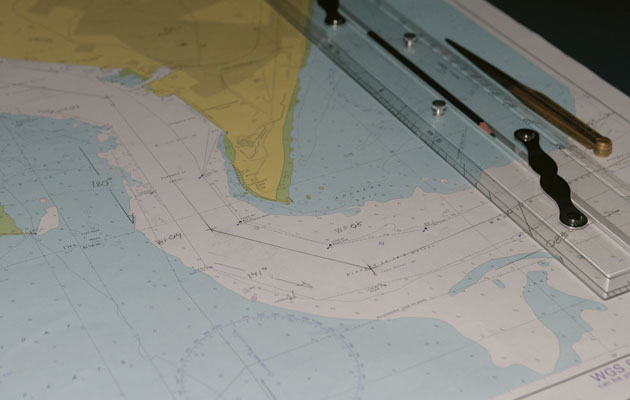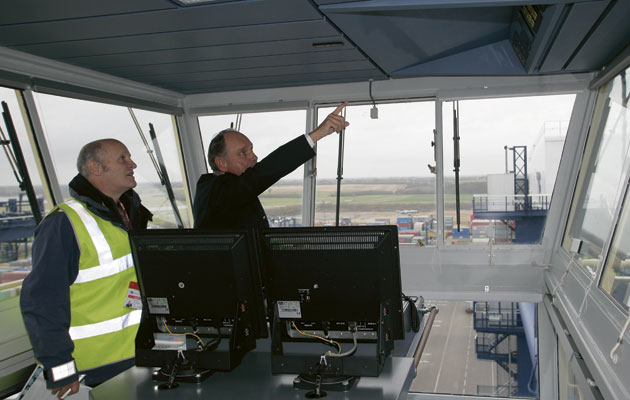Dick Durham meets the master of the ship Emma Maersk, also a yachtsman, to find out how we can stay safe around shipping
On the bridge of a container ship
In 2015, the world’s biggest container ship is the 400m long CSCL Globe, launched in 2014 and capable of carrying a staggering 19,100 TEU containers (Twenty-foot Equivalent Unit). In 2007 it was the 397m Emma Maersk. Launched in 2006 with a draught of 14m and a crew of just 13, Emma Maersk can carry 15,500 TEU containers, enough to fill a train 71km long, holding anything from Mercedes cars to J-cloths. She sails 170,000 nautical miles every year, equal to 7.5 times around the world. She can make a round trip from Gothenburg, Sweden, to Hong Kong, via Felixstowe, the Suez Canal, and Singapore, in 63 days.
Stepping aboard the world’s biggest container ship, the Emma Maersk, at Felixstowe docks, Suffolk, was like standing on the sidewalk in Manhattan trying to see the top of the Empire State Building. Even King Kong would have hesitated. ‘Scaling her gangway is like climbing the north face of the Eiger,’ a dockworker told me.
After two security checks, my photograph was taken for police files and I was given a hard hat and high-visibility fluorescent yellow vest. After a third security check at deck level, I took the lift the final 12 storeys to the bridge of this 397m-long monster ship, to be greeted by the Danish-born Captain, Henrik Solmer, 64.
The Emma Maersk carries 15,500 TEU containers with millions of pounds worth of manufactured goods. Five huge cranes dipped over the ship’s innards, like vultures, removing her containers.

The ship’s trim is constantly checked and corrected with water ballast as containers are loaded and unloaded
In eight hours’ time the ship was due to sail from Felixstowe to Rotterdam. The forecast SW Force 6-7 is not a major issue for a ship as big as this. If it was, Captain Solmer assures me he would slow down or alter course to avoid the worst of the depression. He ushers me into his cabin where his wife, Hanne, is seated.
‘I’m not under pressure in any way. Any schedule is always overruled by the captain if he thinks it necessary. It’s better to be safe than sorry. If you have rough weather in the Atlantic or Pacific in winter it is better to be late than smash up the whole thing. You do not play with Mother Nature’s huge power, you reduce speed,’ Captain Solmer, a yachtsman himself, told me. He cruises the Baltic on a 46ft Sparkman & Stephens ketch with his son Martin.
When your horsepower equals 1,156 family cars and your container capacity is the same as a 71km-long train, and your anchor weighs the equivalent of five adult African elephants, reducing a speed of 26 knots has to be taken seriously, especially as Emma Maersk swings a 128-ton propeller, burning 200 tonnes of fuel a day. We stand looking down on the containers, stacked ten-high below decks and seven-high above. Captain Solmer points out the twistlock fastening screws. He tells me if they become over-stressed a red light flashes up on the computer system.
The ship gets a computer disk delivered from HQ which lists how the containers must be stowed. It always pays to divert from severe weather, says the captain. After 47 years at sea, Captain Solmer knows what to expect. He once slowed down to 10 knots in 25m seas in the Pacific, while in command of another ship. ‘We steamed in the wrong direction, keeping the seas two or three points on each side.’
He watches the weather carefully and will plot a new course even if it means making a longer passage.
An eye out for yachtsmen
Captain Solmer is a firm believer in power giving way to sail outside the shipping lanes. He doesn’t hesitate to reduce speed to 17 knots or less when approaching Dover Strait, or other areas where ‘there are a lot of pleasure craft or fishermen.
‘Maybe the yachtsman doesn’t have an engine, so we have to give way,’ he said. ‘We are all mariners but sometimes people underestimate our speed. I recommend that yachtsmen always use the proper signal if they are motor-sailing, and that they change course early on.’
He also recommends sounding the foghorn. His bridge may be a skyscraper above the sea, but it’s fitted with microphones on the outside, which pick up and give a bearing to any sound they pick up.
‘I do worry about singlehanded sailors. They must get some sleep sometimes and GRP hulls are not always the best radar target so I would recommend using a good radar reflector.’

Despite a hugely sophisticated suite of navigational electronics, Capt Solmer still keeps a track on paper charts
Captain Solmer still has paper charts on his bridge – ‘in case there is a blackout it would be nice to see where I’m drifiting!’ Emma Maersk is also fitted with bow and stern radar, and one on each side of the bridge.








